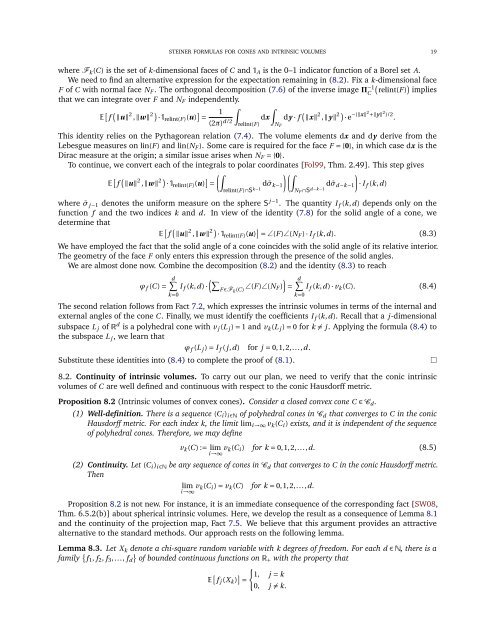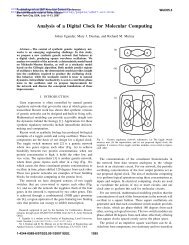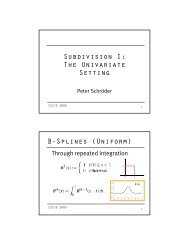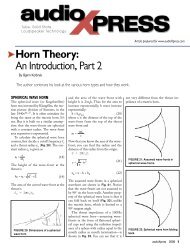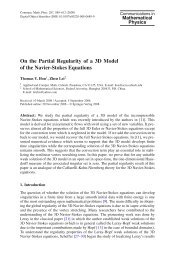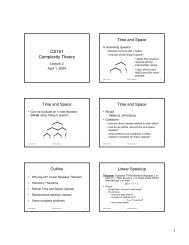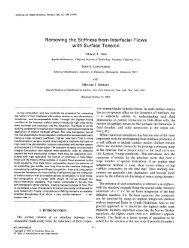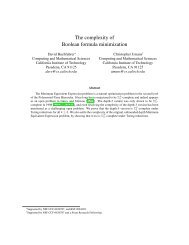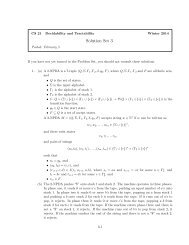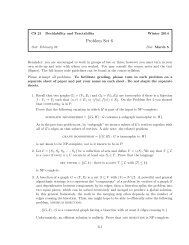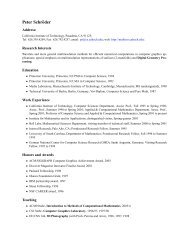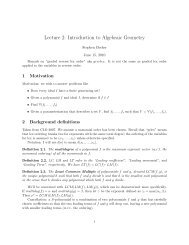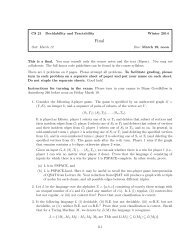From Steiner formulas for cones to concentration of intrinsic volumes
From Steiner formulas for cones to concentration of intrinsic volumes
From Steiner formulas for cones to concentration of intrinsic volumes
Create successful ePaper yourself
Turn your PDF publications into a flip-book with our unique Google optimized e-Paper software.
STEINER FORMULAS FOR CONES AND INTRINSIC VOLUMES 19where F k (C) is the set <strong>of</strong> k-dimensional faces <strong>of</strong> C and 1 A is the 0–1 indica<strong>to</strong>r function <strong>of</strong> a Borel set A.We need <strong>to</strong> find an alternative expression <strong>for</strong> the expectation remaining in (8.2). Fix a k-dimensional faceF <strong>of</strong> C with normal face N F . The orthogonal decomposition (7.6) <strong>of</strong> the inverse image Π −1 ( )C relint(F ) impliesthat we can integrate over F and N F independently.E [ f ( ‖u‖ 2 ,‖w‖ 2 ) · 1 relint(F ) (u) ] ∫1=(2π)∫relint(F d/2 dx dy · f ( ‖x‖ 2 ,‖y‖ 2 ) · e −(‖x‖2 +‖y‖ 2 )/2 .) N FThis identity relies on the Pythagorean relation (7.4). The volume elements dx and dy derive from theLebesgue measures on lin(F ) and lin(N F ). Some care is required <strong>for</strong> the face F = {0}, in which case dx is theDirac measure at the origin; a similar issue arises when N F = {0}.To continue, we convert each <strong>of</strong> the integrals <strong>to</strong> polar coordinates [Fol99, Thm. 2.49]. This step givesE [ f ( ‖u‖ 2 ,‖w‖ 2 ) · 1 relint(F ) (u) ] )=d ¯σ k−1 d ¯σ d−k−1 · I f (k,d)(∫relint(F )∩S)(∫N k−1 F ∩S d−k−1where ¯σ j −1 denotes the uni<strong>for</strong>m measure on the sphere S j −1 . The quantity I f (k,d) depends only on thefunction f and the two indices k and d. In view <strong>of</strong> the identity (7.8) <strong>for</strong> the solid angle <strong>of</strong> a cone, wedetermine thatE [ f ( ‖u‖ 2 ,‖w‖ 2 ) · 1 relint(F ) (u) ] = ∠(F )∠(N F ) · I f (k,d). (8.3)We have employed the fact that the solid angle <strong>of</strong> a cone coincides with the solid angle <strong>of</strong> its relative interior.The geometry <strong>of</strong> the face F only enters this expression through the presence <strong>of</strong> the solid angles.We are almost done now. Combine the decomposition (8.2) and the identity (8.3) <strong>to</strong> reachϕ f (C) =d∑k=0(∑)I f (k,d) ·F ∈F k (C) ∠(F )∠(N F ) =d∑I f (k,d) · v k (C). (8.4)The second relation follows from Fact 7.2, which expresses the <strong>intrinsic</strong> <strong>volumes</strong> in terms <strong>of</strong> the internal andexternal angles <strong>of</strong> the cone C. Finally, we must identify the coefficients I f (k,d). Recall that a j-dimensionalsubspace L j <strong>of</strong> R d is a polyhedral cone with v j (L j ) = 1 and v k (L j ) = 0 <strong>for</strong> k ≠ j. Applying the <strong>for</strong>mula (8.4) <strong>to</strong>the subspace L j , we learn thatϕ f (L j ) = I f (j,d) <strong>for</strong> j = 0,1,2,...,d.Substitute these identities in<strong>to</strong> (8.4) <strong>to</strong> complete the pro<strong>of</strong> <strong>of</strong> (8.1).8.2. Continuity <strong>of</strong> <strong>intrinsic</strong> <strong>volumes</strong>. To carry out our plan, we need <strong>to</strong> verify that the conic <strong>intrinsic</strong><strong>volumes</strong> <strong>of</strong> C are well defined and continuous with respect <strong>to</strong> the conic Hausdorff metric.Proposition 8.2 (Intrinsic <strong>volumes</strong> <strong>of</strong> convex <strong>cones</strong>). Consider a closed convex cone C ∈ C d .(1) Well-definition. There is a sequence (C i ) i∈N <strong>of</strong> polyhedral <strong>cones</strong> in C d that converges <strong>to</strong> C in the conicHausdorff metric. For each index k, the limit lim i→∞ v k (C i ) exists, and it is independent <strong>of</strong> the sequence<strong>of</strong> polyhedral <strong>cones</strong>. There<strong>for</strong>e, we may definek=0v k (C) := limi→∞v k (C i ) <strong>for</strong> k = 0,1,2,...,d. (8.5)(2) Continuity. Let (C i ) i∈N be any sequence <strong>of</strong> <strong>cones</strong> in C d that converges <strong>to</strong> C in the conic Hausdorff metric.Thenlim v k(C i ) = v k (C) <strong>for</strong> k = 0,1,2,...,d.i→∞Proposition 8.2 is not new. For instance, it is an immediate consequence <strong>of</strong> the corresponding fact [SW08,Thm. 6.5.2(b)] about spherical <strong>intrinsic</strong> <strong>volumes</strong>. Here, we develop the result as a consequence <strong>of</strong> Lemma 8.1and the continuity <strong>of</strong> the projection map, Fact 7.5. We believe that this argument provides an attractivealternative <strong>to</strong> the standard methods. Our approach rests on the following lemma.Lemma 8.3. Let X k denote a chi-square random variable with k degrees <strong>of</strong> freedom. For each d ∈ N, there is afamily { }f 1 , f 2 , f 3 ,..., f d <strong>of</strong> bounded continuous functions on R+ with the property thatE [ f j (X k ) ] {1, j = k=0, j ≠ k.□


